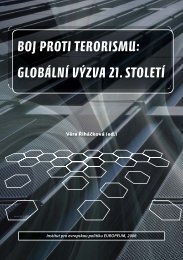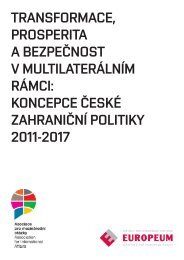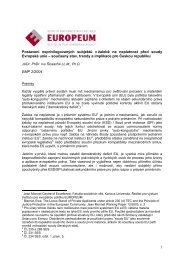eu constitutionalisation - EUROPEUM Institute for European Policy
eu constitutionalisation - EUROPEUM Institute for European Policy
eu constitutionalisation - EUROPEUM Institute for European Policy
You also want an ePaper? Increase the reach of your titles
YUMPU automatically turns print PDFs into web optimized ePapers that Google loves.
Chapter 2: The Convention and IGC Texts of the ConstitutionThe first phase of the Convention endured the longest and witnessed a cleardeliberative style of interaction, actors were on equal footing. The dialoguewas underpinned on the active listening of the others’ point of view and therewas during this moment a reach exchange of arguments on the future re<strong>for</strong>msof the <strong>European</strong> Union. Everyone had the possibility to express the expectationsand wishes. Such a long phase that lasted till the end of July 2002 wasfunctional to create a common sense of belonging to the Convention andlet the representatives of the several components to get to know each other.We can describe this phase a “socialisation stage” of the actors in which theyprofited to get used to work in a new context. This was especially valid <strong>for</strong>the national parliamentarians who were a large majority of the assembly butwere the less accustomed to work in an international assembly.The second phase was that of studying the issues that emerged during thelistening phase. Some 11 working groups were set up with a specific mandateto outline the possible solutions and to make proposition to the plenaryassembly. The third phase was the drafting phase in which the Presidiumpresented the articles of the treaty in relation to the proposal made by theworking groups. After the discussion in the plenary the Presidium progressivelymodified the text according to the debate held in the plenary andaccording to the amendments tabled by the convention members. Thenthere was the final phase aimed at reaching the consensus that was characterizedby fervid negotiation between the institutional components of theassembly. Setting up the working groups was an important change in howthe debate was conducted. The interaction in these small groups had theadvantages of fostering the exchange of substantive arguments rather thanbargaining. Many of the members of the Convention have referred as beingthe base of the <strong>for</strong>mation of the consensus in the Convention²⁷. Howeverit is important to stress the role of the presidium in drafting the mandate ofthe working group. The first set of working group was constituted by fivegroups on: subsidiarity, economic governance, Charter of the Fundamentalrights, juridical personality, the role of national parliaments, complementarycompetence. Shortly after a second set of WG was mandated on the externalaction of the EU, the Defence, the simplification of the legal instruments,Freedom security and justice; the last one was set up in December to discussthe issues related to the social aspects of the Union.Chapter 2: The Convention and IGC Texts of the ConstitutionThese groups were invited to propose concrete solutions to the assemblyand everyone was free to choose in which group to participate accordingto his or her competence. This phase of the working group lasted fromJuly to the end of January when the last group (the one discussing ‘socialEurope’) reported to the assembly.The work of the Convention started to take a more concrete shape withpresentation of the skeleton structure of the draft treaty from VGE²⁸, definingin broad terms the possible structure of the future treaty. This was a keymoment of the Convention in which the possibility to produce a singlelegal text was doing its way onwards. Despite this open atmosphere ofdiscussion during this phase, VGE opposed directly the idea of creatinga working group on the institutional architecture believing that such anissue would have been to much controversial and conflictual. His strategywas to leave this issue <strong>for</strong> the end of the Convention, once a general agreementwas already found. He thought to postpone such a difficult discussionthat would have lead to a conflict and possibly would have proved to bevery counterproductive <strong>for</strong> the dynamics of the Convention.Already at this phase we can see a relevant change in the dynamics of theConvention as the governments started to understand that the Conventionwas becoming a serious business: The sign of such a change was theappointment of the <strong>for</strong>eign affair minister as representative of some governmentsas Spain, France and Germany that, in a certain sense, up-gradedtheir representatives in order to gain a major influence on the process.In this phase it is worth to have a look on the composition of the workinggroups to put in evidence that already at that time the policy variable washaving a clear influence as their composition was changing in relation to theissues they were dealing with. It is interesting to look at the compositionaccording to the criteria of institutional affiliation and titular/alternate toverify how different actors with different resources have tried to participatein the working group in which they could have maximised their influenceby translating their political resources or technical knowledge intoinfluence.27) Intervention of Andrew Duff at the Conference “Towards a <strong>European</strong> Constitution”, Goodenough College,London, 1-2 July 2004.28) Preliminary draft of the Constitutional Treaty (CONV 369/02), 28 October 2002.60 61








